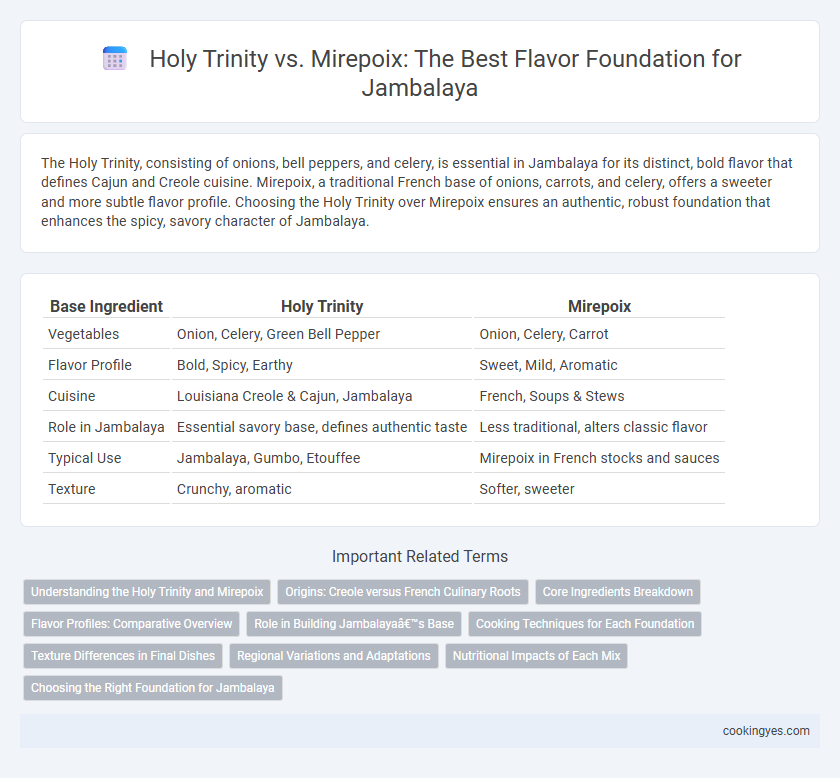The Holy Trinity, consisting of onions, bell peppers, and celery, is essential in Jambalaya for its distinct, bold flavor that defines Cajun and Creole cuisine. Mirepoix, a traditional French base of onions, carrots, and celery, offers a sweeter and more subtle flavor profile. Choosing the Holy Trinity over Mirepoix ensures an authentic, robust foundation that enhances the spicy, savory character of Jambalaya.
Table of Comparison
| Base Ingredient | Holy Trinity | Mirepoix |
|---|---|---|
| Vegetables | Onion, Celery, Green Bell Pepper | Onion, Celery, Carrot |
| Flavor Profile | Bold, Spicy, Earthy | Sweet, Mild, Aromatic |
| Cuisine | Louisiana Creole & Cajun, Jambalaya | French, Soups & Stews |
| Role in Jambalaya | Essential savory base, defines authentic taste | Less traditional, alters classic flavor |
| Typical Use | Jambalaya, Gumbo, Etouffee | Mirepoix in French stocks and sauces |
| Texture | Crunchy, aromatic | Softer, sweeter |
Understanding the Holy Trinity and Mirepoix
The Holy Trinity consists of onions, bell peppers, and celery, serving as the fundamental flavor base in Cajun and Creole cooking, especially in dishes like jambalaya. Mirepoix, a classic French flavor foundation, combines onions, carrots, and celery, offering a sweeter and subtler base commonly used in European cuisines. Understanding the distinction between the Holy Trinity and mirepoix is essential for authentic flavor profiles, as the Holy Trinity imparts a spicier, more robust taste suited to Louisiana dishes.
Origins: Creole versus French Culinary Roots
The Holy Trinity, consisting of bell peppers, onions, and celery, forms the flavor foundation in Creole Jambalaya, reflecting the unique culinary heritage of Louisiana. In contrast, Mirepoix, a classic French base of onions, carrots, and celery, underpins many traditional French dishes, emphasizing the origins of French cuisine. The divergence between the Holy Trinity and Mirepoix highlights the cultural fusion in Creole cooking, where French techniques blend with local ingredients to create distinctive flavors.
Core Ingredients Breakdown
The core ingredients of Jambalaya rely heavily on the Holy Trinity--onions, bell peppers, and celery--which create a distinct and robust flavor foundation essential to Creole and Cajun cuisine. In contrast, Mirepoix consists of onions, carrots, and celery, offering a sweeter and more delicate base commonly used in French cooking. The substitution of bell peppers in the Holy Trinity provides a unique, slightly bitter note that differentiates Jambalaya's bold taste profile from dishes built on Mirepoix.
Flavor Profiles: Comparative Overview
The Holy Trinity, consisting of onions, bell peppers, and celery, forms the foundational flavor profile in Cajun and Creole cuisine, delivering a vibrant and slightly sweet base ideal for jambalaya. Mirepoix, traditionally made of onions, carrots, and celery, offers a sweeter and earthier flavor more common in French culinary practices. The substitution of bell peppers for carrots in the Holy Trinity enhances the dish's boldness and regional authenticity, distinguishing jambalaya's taste from dishes using mirepoix.
Role in Building Jambalaya’s Base
The Holy Trinity, consisting of onions, bell peppers, and celery, forms the essential flavor foundation unique to jambalaya, imparting a distinct Creole character. In contrast, mirepoix blends onions, carrots, and celery, commonly used in French cuisine but altering the sweet and savory profile critical to authentic jambalaya. Using the Holy Trinity highlights the dish's regional heritage and ensures the robust, aromatic base essential for its rich, layered taste.
Cooking Techniques for Each Foundation
The Holy Trinity, consisting of onions, bell peppers, and celery, provides a robust, aromatic base essential for authentic Cajun and Creole jambalaya, typically sauteed in oil or butter to release its deep flavors. Mirepoix, a classic French mirepoix of onions, carrots, and celery, is gently sweated in oil or butter, offering a sweeter and milder flavor that forms the foundation of many European dishes but yields a subtler taste in jambalaya. Proper cooking techniques for the Holy Trinity involve high heat to caramelize and develop complex notes, while mirepoix requires low and slow cooking to soften vegetables without browning, impacting the overall flavor profile of the dish.
Texture Differences in Final Dishes
The Holy Trinity in jambalaya, consisting of onions, bell peppers, and celery, provides a crisp and vibrant texture that enhances the dish's overall mouthfeel, creating distinct vegetable bites amidst the rice and protein. Mirepoix, typically composed of onions, carrots, and celery, offers a mellower texture with softer, more uniformly cooked vegetables, resulting in a smoother, more integrated base flavor. This textural contrast influences jambalaya's sensory experience, with the Holy Trinity delivering a brighter chew and mirepoix blending seamlessly into the sauce.
Regional Variations and Adaptations
Jambalaya's flavor foundation often hinges on the Holy Trinity--onion, celery, and bell pepper--key in Cajun and Creole cuisines to create authentic depth and spice. In contrast, mirepoix, consisting of onion, celery, and carrot, is more common in French cooking and less typical in Louisiana variants, reflecting European influence rather than Southern U.S. tradition. Regional adaptations emphasize the Holy Trinity for its vibrant taste profile, while some modern recipes incorporate mirepoix elements to blend classic French techniques with Southern flavors.
Nutritional Impacts of Each Mix
The Holy Trinity, consisting of onions, bell peppers, and celery, offers a rich source of vitamins A, C, and fiber, enhancing Jambalaya's nutritional profile with antioxidants and essential minerals. Mirepoix, made up of onions, carrots, and celery, provides higher beta-carotene and vitamin A content due to carrots, supporting immune health and vision. Choosing between these flavor bases influences not only taste but also the nutritional benefits, tailoring the dish's health value with either enhanced antioxidant intake or vitamin richness.
Choosing the Right Foundation for Jambalaya
Choosing the right flavor foundation for jambalaya hinges on understanding the Holy Trinity--onions, celery, and green bell peppers--which delivers the authentic Creole and Cajun taste essential to the dish. Mirepoix, composed of onions, carrots, and celery, introduces a milder, sweeter flavor profile but lacks the distinctive pepper bite that defines jambalaya's depth. Emphasizing the Holy Trinity ensures the bold, spicy, and savory character that makes jambalaya a quintessential Louisiana specialty.
Holy Trinity vs Mirepoix for flavor foundation Infographic

 cookingyes.com
cookingyes.com